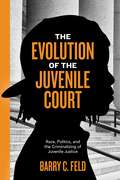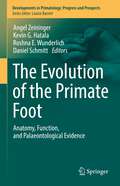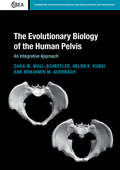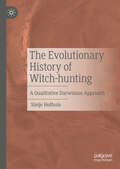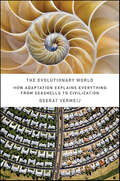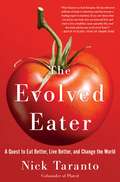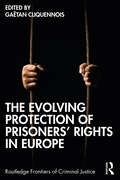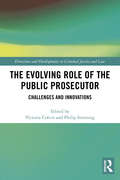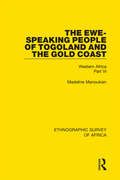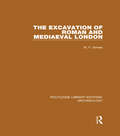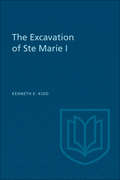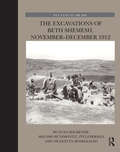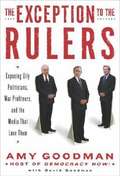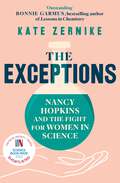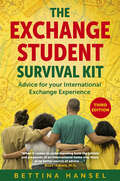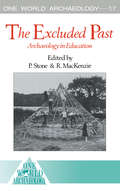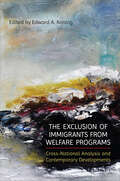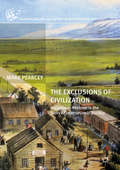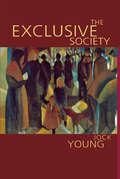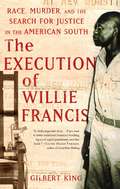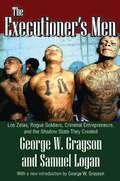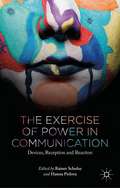- Table View
- List View
The Evolution of the Juvenile Court: Race, Politics, and the Criminalizing of Juvenile Justice (Youth, Crime, and Justice #4)
by Barry FeldFrom one of America&’s leading experts, an analysis of the history of the nation&’s juvenile justice system and a look at the future. The juvenile court lies at the intersection of youth policy and crime policy, and reflects our changing ideas about children and crime control throughout history. In The Evolution of the Juvenile Court, noted law professor and criminologist Barry C. Feldprovides a sweeping overview of the American juvenile justice system&’s development and change over the past century. Feld traces the juvenile court&’s evolution though its four periods―the Progressive Era, the Due Process Revolution in the 1960s, the Get Tough Era of the 1980s and 1990s, and today&’s Kids Are Different era. He examines the relationship between social structural factors—changes in the economy, cities, families, race and ethnicity, and politics—and their impact on juvenile justice policies and practices. A comprehensive analysis of juvenile justice history, The Evolution of the Juvenile Court draws on lessons from our past to envision a new, developmentally appropriate justice system for children. Winner, 2020 ACJS Outstanding Book Award, given by the Academy of Criminal Justice Sciences
The Evolution of the Primate Foot: Anatomy, Function, and Palaeontological Evidence (Developments in Primatology: Progress and Prospects)
by Daniel Schmitt Angel Zeininger Kevin G. Hatala Roshna E. WunderlichThe human foot is a unique and defining characteristic of our anatomy. Most primates have grasping, prehensile feet, whereas the human foot stands out as a powerful non-grasping propulsive lever that is central to our evolution as adept bipedal walkers and runners and defines our lineage. Very few books have compiled and evaluated key research on the primate foot and provided a perspective on what we know and what we still need to know. This book serves as an essential companion to “The Evolution of the Primate Hand” volume, also in the Developments in Primatology series. This book includes chapters written by experts in the field of morphology and mechanics of the primate foot, the role of the foot in different aspects of primate locomotion (including but not limited to human bipedalism), the “hard evidence” of primate foot evolution including fossil foot bones and fossil footprints, and the relevance of our foot’s evolutionary history to modern human foot pathology.This volume addresses three fundamental questions: (1) What makes the human foot so different from that of other primates? (2) How does the anatomy, biomechanics, and ecological context of the foot and foot use differ among primates and why? (3) how did foot anatomy and function change throughout primate and human evolution, and why is this evolutionary history relevant in clinical contexts today?This co-edited volume, which relies on the insights of leading scholars in primate foot anatomy and evolution provides for the first time a comprehensive review and scholarly discussion of the primate foot from multiple perspectives. It is accessible to readers at different levels of inquiry (e.g., undergraduate/graduate students, postdoctoral research, other scholars outside of biological anthropology). This volume provides an all-in‐one resource for research on the comparative and functional morphology and evolution of the primate foot.
The Evolutionary Biology of the Human Pelvis: An Integrative Approach (Cambridge Studies in Biological and Evolutionary Anthropology #85)
by Benjamin M. Auerbach Cara M. Wall-Scheffler Helen K. KurkiThis book provides a synthetic overview of all evidence concerning the evolution of the morphology of the human pelvis, including comparative anatomy, clinical and experimental studies, and quantitative evolutionary models. By integrating these lines of research, this is the first book to bring all sources of evidence together to develop a coherent statement about the current state of the art in understanding pelvic evolution. Second, and related to this, the volume is the first detailed assessment of existing paradigms about the evolution of the pelvis, especially the obstetric dilemma. The authors argue that there are many 'dilemmas', but these must be approached using a testable methodology, rather than on the proviso of a single paradigm. The volume clearly contributes to greater scientific knowledge about human variation and evolution, and has implications for clinicians working within reproductive health. A thought-provoking read for students, researchers and professionals in the fields of biological anthropology, human evolutionary anthropology, paleoanthropology, bioarchaeology, biology, developmental biology and obstetrics.
The Evolutionary History of Witch-hunting: A Qualitative Darwinian Approach
by Steije HofhuisWhy did early modern Europeans hunt for witches? Were these persecutions a shrewd tool to oppress women or the poor, or were they just a way of making money? Or were witch-hunters primarily driven by a genuine belief in witchcraft? The witches’ sabbath, the diabolical pact, and the nightly flight were elements in the early modern concept of witchcraft that seem to have been intelligently designed to trigger persistent witch persecutions. But in contrast to what many past historical scholars presumed, witch-hunts were not based on intelligent design. So how to explain them? This book proposes a new model: Darwinian cultural evolution. It contends that witch-hunting’s apparent design emerged from a hidden evolutionary process in which cultural variants which accidentally unleashed larger persecutions were cumulatively preserved. Witch-hunting did not so much evolve to serve human interests but to ensure its own ‘selfish’ reproduction. Historians have often compared witch persecutions to the outbreaks of contagious disease, but only as a figure of speech. But shouldn’t we take the similarities more seriously? This book argues that witch-hunting was a cultural ‘virus’ that spread at the expense of its human hosts, and thus bridges the gap between qualitative history and the burgeoning field of Darwinian cultural evolution.
The Evolutionary World: How Adaptation Explains Everything from Seashells to Civilization
by Geerat J. Vermeij"One of the master naturalists of our time" (American Scientist) reveals how evolutionary theory explains and affects not just the natural world but our society---and its future.Evolution has outgrown its original home in biology and geology. The Evolutionary World shows how evolution---descent with modification---is a concept that organizes, explains, and predicts a multitude of unconnected facts and phenomena. Adaptation plays a role not only in the development of new species but the development of human civilization. By understanding how evolutionary theory has played out in areas such as our economic system, our preparation for catastrophes, and even the development of communities, we can learn not just how these systems work but also what challenges lie ahead.Blind since the age of three, Dr. Geerat J. Vermeij has become renowned for his unique abilities to recognize details in the natural world that other scientists would never have noticed. In this book, he presents a new argument for evolution's broader importance. He explores similarities between genomes and languages, the contrasting natural economies of islands and continents, the emergence and importance of human values, the long-range consequences of global warming, and the perils of monopoly. He also shows that the lessons of evolution have implications for education, our system of laws, and economic growth. The Evolutionary World makes a fascinating argument about the broad-reaching impact and importance of evolution. It offers a way for us to understand and work with evolution's principles so that we can devise better solutions for our own lives, society, and the environment around us.
The Evolved Eater: A Quest to Eat Better, Live Better, and Change the World
by Nick TarantoFrom the co-founder of Plated, the home delivery food service, an inspirational business title that is a call-to-arms and investigation into the industrial American food complex.In early 2012, Nick Taranto was twenty-seven years old, recently married, and fresh out of the Marine Corps. He moved back to New York City, started working on Wall Street, and put on twenty pounds in under six months. He was pasty, overweight, and depressed – and he knew there had to be a better way to eat (and live). The Evolved Eater chronicles his quest to change how we eat, and what this means for the future of food. As the co-founder of Plated, which has delivered tens of millions of meals across the country in its first five years, Taranto cares about the food we eat. As Evolved Eaters, we strive to continually improve and evolve as we grow through life. And eating – and being close to the food you cook and consume – is an inseparable part of this evolution. Americans throw away over 300 billion pounds of food each year, while millions of children are food insecure or poorly nourished. How did the most food abundant nation in history get this vital issue so wrong?Taranto provides eye-opening facts about how we acquire and eat food and easy and practical things that you can do to improve the way you eat (and live) starting today. Eating doesn’t need to be complicated or painful or over-thought. We’re starting The Evolved Eater revolution right here, right now.
The Evolving Protection of Prisoners’ Rights in Europe (Routledge Frontiers of Criminal Justice)
by Gaëtan CliquennoisThe Evolving Protection of Prisoners’ Rights in Europe explores the development of the framing of penal and prison policies by the European Court of Human Rights (ECHR), clarifying the European expectations of national authorities, and describing the various models existing in Europe, with a view to analysing their mechanisms and highlighting those that seem the most suitable. A new frame of penal and prison policies in Europe has been progressively established by the ECHR and the Council of Europe (CoE) to protect the rights of detainees in Europe. European countries have reacted very diversely to these policies. This book has several key benefits for readers: · A global and detailed overview of the ECHR jurisprudence on penal and prison policies through an analysis of its development over time. · An analysis of the interactions between the Strasbourg Court and the CoE bodies (Committee of Ministers, Committee for the Prevention of Torture…) and their reinforced framing of domestic penal and prison policies. · A detailed examination of the impacts of the European case law on penal and prison policies within 10 nation states in Europe (including Romania which is currently very under-researched). · A robust engagement with the diverse national reactions to this European case law as a policy strategy. This book will be of great interest to scholars and students of Law, Criminal Justice, Criminology, and Sociology. It will also appeal to civil servants (judges, lawyers, etc.), professionals and policymakers working for the CoE, the European Union, and the United Nations; Ministries of Justice; prison departments; and human rights institutions, as well as activists working for INGOs and NGOs.
The Evolving Relationship between China, the EU and the USA: A New Global Order? (Routledge Studies on Comparative Asian Politics)
by Simon Schunz Duncan Freeman Jing MenThis book closely scrutinizes the individual and collective roles played by China, the EU and the USA in contemporary world politics. Examining the three actors’ respective strategic and policy positions on and behaviour towards the flux of the contemporary global order, the analysis focuses on three major issues and challenges: foreign and security policy; economics and trade; and climate change and energy. Discussing their relative power, as well as their interests, beliefs and positions on a set of decisive issues, this book explores bilateral relations between the three powers and the ways in which they may interact trilaterally in a broader global context to shape international politics. Written by a stellar line-up of experts from the fields of politics and international relations, The Evolving Relationship between China, the EU and the USA will be of huge interest to students and scholars from within these fields, as well as policy-makers and practitioners more generally.
The Evolving Role of the Public Prosecutor: Challenges and Innovations
by Victoria Colvin Philip StenningThe modern public prosecutor is a figure both powerful and enigmatic. Legal scholars and criminologists often identify “three essential components” of criminal justice systems: police, courts and corrections. Yet increasingly, the public prosecutor occupies a distinct role independent from any of these branches. Acting outside of the court, and therefore largely out of the public eye, the prosecutor’s control over whether and what charges proceed to court can limit judicial discretion on sentencing, open pathways to alternative measures and even deny entry into the criminal justice system entirely. In this sense the prosecutor serves as a true “gatekeeper” to the criminal process. This book addresses key aspects of the evolving role of domestic and international prosecutors in common law and civil law systems in the twenty-first century, and the challenges posed by this evolution. This collection of chapters from respected scholars takes an international, comparative approach and explores how these different legal systems have borrowed theorisations and articulations of the prosecutorial role from each other in adapting the office to changing conditions and expectations. The volume is structured around four main themes relating to the role of the modern prosecutor: the nature of the prosecutor’s office, the role of the prosecutor in investigations, prosecutorial discretion and how it is exercised, and politicisation and accountability of prosecutors. This book is essential for scholars and students in criminal justice, pre-law/legal studies, criminology, justice studies and political science, and is useful as a resource for those interested in legal change around the world.
The Ewe-Speaking People of Togoland and the Gold Coast: Western Africa Part VI
by Madeline ManoukianRoutledge is proud to be re-issuing this landmark series in association with the International African Institute. The series, published between 1950 and 1977, brings together a wealth of previously un-co-ordinated material on the ethnic groupings and social conditions of African peoples. Concise, critical and (for its time) accurate, the Ethnographic Survey contains sections as follows: Physical Environment Linguistic Data Demography History & Traditions of Origin Nomenclature Grouping Cultural Features: Religion, Witchcraft, Birth, Initiation, Burial Social & Political Organization: Kinship, Marriage, Inheritance, Slavery, Land Tenure, Warfare & Justice Economy & Trade Domestic Architecture Each of the 50 volumes will be available to buy individually, and these are organized into regional sub-groups: East Central Africa, North-Eastern Africa, Southern Africa, West Central Africa, Western Africa, and Central Africa Belgian Congo. The volumes are supplemented with maps, available to view on routledge.com or available as a pdf from the publishers.
The Excavation of Roman and Mediaeval London (Routledge Library Editions: Archaeology)
by W. F. GrimesThis is an immensely fascinating work, published originally in 1968, which is of great value in understanding London’s past. The immediate background to the excavations was the bombing of London during the Second World War, which led to the destruction of more than fifty of the three hundred and fifty or so acres that make up the walled city. The interval before rebuilding was a magnificent opportunity for archaeological excavation. The Royal Society of Antiquaries of London established the Roman and Mediaeval London Excavation Council to organise an extended programme which began in July 1947 and went on until 1962. This volume reports on the major series of excavations and deals in detail with Cripplegate, the Temple of Mithras and many mediaeval churches including St Bride’s, Fleet Street.
The Excavation of Ste Marie I
by Kenneth E. KiddThis report sets forth the results of the excavation of the site known as Ste Marie I on the Wye River, near Midland, Ontario. It is hoped that it will be in some measure a contribution to our knowledge of a small but important episode in Canadian history; namely, the activities of the Jesuit Fathers in the decade of their residence among the Huron Indians. <P><P>In the decade of their residence among the Hurons, the Jesuits attempted to build a native commonwealth founded on Christian belief: an attempt which was suddenly and utterly ended by the Iroquois raids of 1649. The very heart and core of this famous enterprise was the establishment called by the Jesuits themselves Ste Marie. Hitherto, knowledge of it has been confined to what could be learned from written records; this can now be augmented, especially in regard to its physical aspects, with the information obtained by means of archaeology, and presented in this report.
The Excavations of Beth Shemesh, November-December 1912 (The Palestine Exploration Fund Annual)
by Duncan MacKenzie Shlomo Bunimovitz Zvi Lederman Nicoletta MomiglianoIn 1909 the Scottish archaeologist Duncan Mackenzie, Sir Arthur Evans’s right-hand man on the excavations of the legendary ‘Palace of Minos’ at Knossos since 1900, was appointed ‘Explorer’ of the Palestine Exploration Fund (PEF). From the spring of 1910 until December 1912 he was engaged in archaeological fieldwork in Palestine, especially directing excavation campaigns at Ain Shems (biblical Beth Shemesh) – an important site in the Shephelah of Judah at the crossroads of Canaanite, Philistine, and Israelite cultures. Mackenzie published the results of his work in various issues of the Palestine Exploration Quarterly and Palestine Exploration Fund Annual. Because of a financial dispute with the PEF, however, he never submitted a detailed publication of his very last campaign at Beth Shemesh, conducted in November–December 1912. <P><P>In 1992 Nicoletta Momigliano rediscovered Mackenzie’s lost manuscript on his latest discoveries at Beth Shemesh, which one of his nephews had kept for nearly 80 years at his old family home in the Scottish Highlands, in the small village of Muir of Ord. At about the same time, Shlomo Bunimovitz and Zvi Lederman initiated new excavations at Beth Shemesh which considerably changed previous interpretations of the site. This volume presents Mackenzie’s detailed discussion of his last excavations at Beth Shemesh in the light of these more recent discoveries. Although written over a century ago, Mackenzie’s manuscript deserves to be better known today; it not only provides significant new information on this important site but also constitutes an intriguing historical document, shedding light on the history of field archaeology and of biblical archaeology. Moreover, Mackenzie’s pioneering approach to archaeological fieldwork and the significance of his finds can often be better appreciated today, from the perspective of more recent developments and discoveries.
The Exception to the Rulers: Exposing Oily Politicians, War Profiteers, and the Media that Love Them
by Amy Goodman David GoodmanHost of Pacifica Radio's Democracy Now! Analyzes world events.
The Exceptions: Nancy Hopkins and the fight for women in science
by Kate Zernike&‘Outstanding&’ Bonnie Garmus, bestselling author of Lessons in ChemistryThe remarkable untold story of how a group of sixteen determined women used the power of the collective and the tools of science to inspire ongoing radical change. This is a triumphant account of progress, whilst reminding us that further action is needed. These women scientists entered the work force in the 1960s during a push for affirmative action. Embarking on their careers they thought that discrimination against women was a thing of the past and that science was a pure meritocracy. Women were marginalized and minimized, especially as they grew older, their contributions stolen and erased. Written by the Pulitzer Prize-winning journalist who broke the story in 1999 for The Boston Globe, when the Massachusetts Institute of Technology made the astonishing admission that it discriminated against women on its faculty, The Exceptions is an intimate narrative which centres on Nancy Hopkins – a surprisingly reluctant feminist who became a hero to two generations of women in science. In uncovering an erased history, we are finally introduced to the hidden scientists who paved the way for collective change.
The Exchange Student Survival Kit 3rd Edition: Advice for your International Exchange Experience
by Bettina HanselFOR STUDENTS GOING ABROAD, THE EXCHANGE STUDENT SURVIVAL KIT IS THE FIRST THING TO PACK!Study exchange has never been more important. Ask anyone who has been an exchange student. As we come more and more to realize how interconnected our world is, living for a time in another culture may be the most valuable experience a young person needs in the 21st Century.Students embarking on this life-changing adventure need tried-and-true advice. THE EXCHANGE STUDENT SURVIVAL KIT is the essential guide for young people interested in traveling abroad on an international exchange program. In an approach that documents each phase of the experience, it shows students how to avoid many common misunderstandings and problems that can occur in the course of their adjustment to a new culture, a new family, a new school and a new community.The book is full of examples taken from the experiences of dozens of exchange students from a broad spectrum of cultures and shows how to manage the unexpected "culture shock" and deal with the specific issues that emerge when immersing yourself in an unfamiliar culture.
The Excluded Past: Archaeology in Education (One World Archaeology #No.17)
by Peter Stone Robert MacKenzieA ground-breaking book that examines the uneasy relationship between archaeology and education. Argues that archaeologists have a vital role to play in education alongside other interpreters of the past. Contributors from different countries and disciplines show how the exclusion of aspects of the past tends to impoverish and distort social and educational experience.
The Exclusion of Immigrants from Welfare Programs: Cross-National Analysis and Contemporary Developments
by Edward A. KoningIn light of the increase in cross-border mobility and the recent political climate surrounding immigration-related issues, understanding the politics and policies of immigrants’ access to welfare programs is more relevant than ever. Systematic analysis of this subject has been held back, however, by the lack of a cross-national index of immigrant exclusion from social benefits over time. The Exclusion of Immigrants from Welfare Programs fills this gap by taking advantage of a novel and original measure called the Immigrant Exclusion from Social Programs Index (IESPI), which includes twenty-five indicators regarding immigrants’ access to seven different social programs, for twenty-two countries, at four moments in time. The book includes an assessment of key trends, an investigation of the origins and consequences of variation, and four detailed country case studies of particular theoretical interest: Norway, Austria, Portugal, and the United States. Presenting a cross-national index to facilitate and encourage systematic cross-country comparisons, this book provides insights and data that will allow researchers to probe such questions as the degree to which countries include or exclude immigrants in developing public policies, why some countries are more exclusionary than others, and what the future consequences of this exclusion might be.
The Exclusions of Civilization
by Mark PearceyThis book builds upon an inter-disciplinary body of literature to detail the centrality of European colonialism and imperialism in the constitution of modern international relations. A critical historical analysis that challenges conventional assumptions about the evolution and expansion of international society, it addresses the interconnections between the European and non-European sides of that history. Pearcey argues that features of European expansion were guided by a discourse on civilization, one that subsumed the uncivilized Other within the boundaries of the civilized Self. Doing so, civilization enabled a process of "exclusion by inclusion", whereby many of the world's indigenous peoples were gradually excluded from the "international" by being subsumed within the "domestic. " Challenging conventional assumptions about the evolution and expansion of international society, especially those of the English School, this book contributes to central debates in International Relations theory.
The Exclusive Society: Social Exclusion, Crime and Difference in Late Modernity
by Professor Jock YoungIn this major new work, which Zygmunt Bauman calls a 'tour de force of breathtaking erudition and clarity', Jock Young charts the movement of the social fabric in the last third of the twenthieth century from an inclusive society of stability and homogeneity to an exclusive society of change and division. Jock Young, one of the foremost criminologists of our time, explores exclusion on three levels: economic exclusion from the labour market; social exclusion between people in civil society; and the ever-expanding exclusionary activities of the criminal justice system. Taking account of the massive dramatic structural and cultural changes that have beset our society and relating these to the quantum leap in crime and incivilities, Jock Young develops a major new theory based on a new citizenship and a reflexive modernity.
The Excruciating History of Dentistry: Toothsome Tales & Oral Oddities from Babylon to Braces
by James WynbrandtAn “entertaining history” of the practice of dentistry that will remind you how lucky you are to live in the modern era (Publishers Weekly).For those on both sides of the dreaded dentist’s chair, James Wynbrandt has written a witty, colorful, and richly informative history of the art and science of dentistry. To all of those dental patients whose whine rises in tandem with that of the drill, take note: You would do well to stifle your terror and instead offer thanks to Apollonia, the patron saint of toothache sufferers, that you face only fleeting discomfort rather than the disfiguring distress or slow agonizing death oft meted out by dental-care providers of the past. The transition from yesterday’s ignorance, misapprehension, and superstition to the enlightened and nerve-deadened protocols of today has been a long, slow, and very painful process—as shown by such facts as:*Among the toothache remedies favored by Pierre Fauchard, the father of dentistry, was rinsing the mouth liberally with one’s own urine.*George Washington never had wooden teeth. However, his chronic dental problems may have impacted the outcome of the American Revolution.*Soldiers in the Civil War needed at least two opposing front teeth to rip open powder envelopes. Some men had their front teeth extracted to avoid service.*Teeth were harvested from as many as fifty thousand corpses after the Battle of Waterloo, a huge crop later used for dentures and transplants that became known as “Waterloo Teeth.”“You’ll gain a great deal of dental knowledge, acquired quite painlessly.” —The New York Times Book Review“Just the thing you need to get through your next oral probing.” —Entertainment Weekly“A breezy romp . . . While sensitive dentists may wince at having their profession’s rough-and-tumble past revealed, dental patients are more likely to feel relief at having been born in the modern era of dentistry. Both groups are in for a good laugh.” —Kirkus Reviews
The Execution of Admiral John Byng as a Microhistory of Eighteenth-Century Britain
by Joseph J. KrulderAccording to Voltaire's Candide, Admiral John Byng's 1757 execution went forward to 'encourage the others'. Of course, the story is more complicated. This microhistorical account upon a macro-event presents an updated, revisionist, and detailed account of a dark chapter in British naval history. Asking 'what was Britain like the moment Byng returned to Portsmouth after the Battle of Minorca (1756)?' not only returns a glimpse of mid-eighteenth century Britain but provides a deeper understanding of how a wartime admiral, the son of a peer, of some wealth, a once colonial governor, and sitting member of parliament came to be scapegoated and then executed for the failings of others. This manuscript presents a cultural, social, and political dive into Britain at the beginning of the Seven Years' War. Part 1 focuses on ballad, newspaper, and prize culture. Part 2 makes a turn towards the social where religion, morality, rioting, and disease play into the Byng saga. Admiral Byng's record during the 1755 Channel Campaign is explored, as is the Mediterranean context of the Seven Years' War, troubles elsewhere in the empire, and then the politics behind Byng's trial and execution.
The Execution of Willie Francis: Race, Murder, and the Search for Justice in the American South
by Gilbert KingOn May 3, 1946, in St. Martinsville, Louisiana, a seventeen-year-old black boy was scheduled for execution by electric chair. Willie Francis had been charged with murder; his trial had been brief; his death sentence never in doubt. When the executioners flipped the switch, Willie screamed and writhed as electricity coursed through his body. But Willie Francis did not die. Having miraculously survived, Willie was informed that the state would attempt to execute him a second time within a week. The ensuing legal battle went all the way to the Supreme Court, asking: Could the state electrocute someone twice? A gripping narrative about a brutal crime and its shocking aftermath, The Execution of Willie Francis offers a heroic--and ultimately tragic--tale of one man's quest for moral justice in a nation still blinded by race.
The Executioner's Men: Los Zetas, Rogue Soldiers, Criminal Entrepreneurs, and the Shadow State They Created
by George W. GraysonLos Zetas represent a new generation of ruthless, sadistic pragmatists in Mexico and Central America who are impelling a tectonic shift among drug trafficking organizations in the Americas. Mexico's marines have taken down the cartel's top leaders; nevertheless, these capos and their desperados have forever altered how criminal business is conducted in the Western Hemisphere. This narrative brings an unprecedented level of detail in describing how Los Zetas became Mexico's most diabolical criminal organization before suffering severe losses.In their heyday, Los Zetas controlled networks of American police, politicians, judges, and businessmen. The Mexican government is losing its "war on drugs," despite the military, technical, and intelligence resources provided by its northern neighbor. Subcontracted street gangs operate in hundreds of US cities, purchasing weapons, delivering product, executing targeted foes, and bribing the US Border Patrol. Despite crippling losses Los Zetas still dominate Nuevo Laredo, the major portal for legal and illegal bilateral commerce. They also work hand-in-glove with the underworld in Guatemala, El Salvador, and Honduras, as well as with gangs like the Maras Salvatruchas.
The Exercise of Power in Communication
by Rainer Schulze Hanna PishwaPower Exercise explores the various choices speakers or communicators make when expressing power relations in modern societies. The volume brings together several disciplines, such as linguistics, sociology, communication studies and social psychology, to give insight into how interactants co-construct different aspects of power in their everyday life. The chapters reveal that the power potential of linguistic elements is dependent on context and is by no means fixed or predetermined, whichprovides implications for research methodology.
